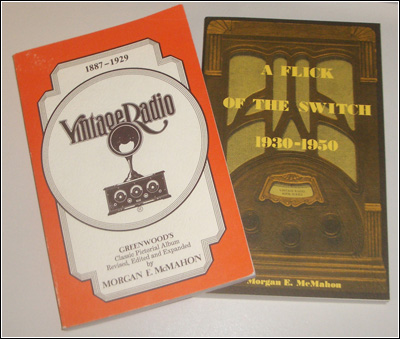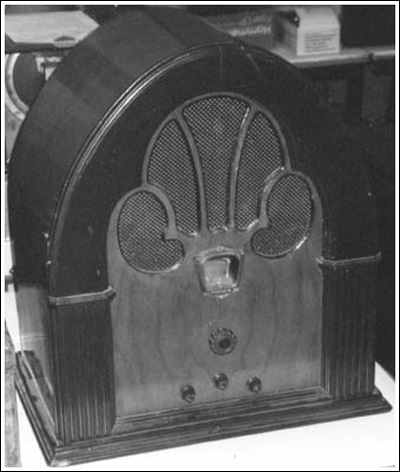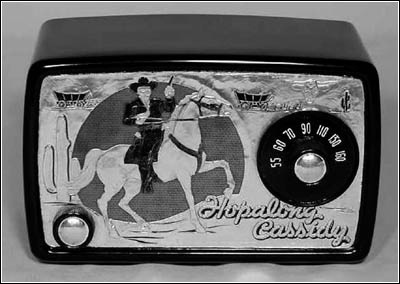Of Old Radios And Related Items--Published Monthly
The Hunt for Old Radios -- Eight Tips
by John Miller
Web Edition
Having been a collector for over three decades, John Miller gives us eight tips to find "something" for your collection. He also tells us how following the advice he shares here has helped him to grow as a collector. (Editor)
Back in the mid-1980s a new collector came over to view my collection, and after seeing several of my cathedral sets, he remarked, "Wow, I didn't realize how easy those are to find." While I certainly don't consider cathedrals, or many other old radios easy to find, I have stumbled onto a few tips over the last 30-odd years or so that you may find useful in locating old radios. As I reminisce about how my collection grew, perhaps you'll find an idea that will help you add more sets to your collection.
Back in the mid-1970s my collecting bible was A Flick of the Switch 1930-1950 by Morgan E. McMahon. That book and its companion Vintage Radio 1887-1929, also by McMahon, were the only reference books available to collectors at the time. Since my interest leaned toward cathedral-style radios, I used to scan the pages of A Flick of the Switch 1930-1950 dreaming of the day I'd locate my first cathedral.
It was, in fact, at least three to five years later before I located the first cathedral to grace my collection. A friend told me about a radio he saw advertised in the newspaper classifieds he thought I'd be interested in. There was no mention of the style or model number, just the description, "Old Philco radio, 110-volt." That Philco turned out to be a Model 20 cathedral that I purchased for $25.
The early radio collector's bibles.Tip 1
I'll never forget the thrill of finding that set and carefully bringing it home. In fact, for many years I kept a copy of that small classified ad. So TIP 1 is to look in the classified ad section of newspapers in your local area. You may also want to run a "wanted" ad in the same papers, although it has been my personal experience that those didn't yield very good results; however you may have better luck.
Tip 2
I then heard about a monthly flea market in Washington Courthouse, Ohio. That proved to be a fairly good place to find radios; in fact, I bought my 1938 Zenith 9S262 console (still one of my favorite sets) there for $25 in 1979. If I recall correctly, I found perhaps three or four cathedrals there over a period of a few years, but not very many. Although my collection was increasing little by little, I wasn't finding the cathedrals I so desperately wanted. In any case, TIP 2 is to hunt through flea markets whenever you see one. If you have to drive two to four hours to find a really large flea market, the trip will be worth your while. But get there early! Other radio collectors will be out in force, and if you sleep in, you'll most likely miss the best pickings.
On the other hand, if you happen on one during a late Saturday or Sunday drive, don't hesitate to stop. There's always a chance that a collectible radio showed up after the early horde of collectors left, or the price that was initially too high has come down to a reasonable level. And don't forget about your local Hamfest. These huge events often have everything from old radios to modern computers -- a great place to find parts at very reasonable prices. Once again, if looking for old radios, the key here is to get there early. It was at the 1980 Dayton, Ohio, Hamfest that I found the Philco 90 cathedral that still sits on my shelf today.
Tip 3
For me, the turning point from finding a radio scattered here and there to doing serious collecting was finding out about the Indiana Historical Radio Society (IHRS) in the late 1970s. Going to their annual spring meet, held at the time in Auburn, Indiana, was for me, like throwing a kid into a candy store! Rather than walking through a flea market trying to locate a "radio in a haystack," here was one location where the only thing people were selling were old radios!
To this day my fondest radio collecting memories are of the spring IHRS meets held at the Auburn-Cord-Duesenburg Museum in Auburn. It was at the first IHRS meet that I met my good friend and very prolific cathedral collector Frank Heathcote. It was also where, in 1981, I obtained my first West-Coast cathedral, a Zaney Gill Music Box in 1981 and my Zenith Walton in 1985.
Through membership in the IHRS, my knowledge of collecting, restoration, and historical significance of old radio grew. I've met many friends from those Auburn days in the late 70s and 80s, many of whom are still close friends.
Philco Model 70 (an A.R.C. archive photo).Through the IHRS, I also learned of the Antique Wireless Association (AWA) and the Antique Radio Club of America (ARCA), which later merged with the AWA. The AWA had a very large annual meet in Canandaigua, New York, later moved to Rochester, New York, whereas ARCA had its large annual meet at different locations each year.
The AWA flea market was larger than I ever imagined. Many radios in my collection came via the 10-hour drive to Canandaigua in the early to mid-1980s -- sets like my Philco 70 and my beautiful Splitdorf Abbey battery set in 1981; a rare Emerson Model 35 and a rare Radiochron large cathedral with a clock in 1982; a Sterling Little Symphony cathedral in 1983; an Arvin Hopalong Cassidy and a rare Belknap cathedral in 1984, just to name a few.
It was during a June IHRS meet, back about 1981 or so, that Illinois radio collector Joe Willis came up with the idea of three radio clubs hosting a "mega" meet in Elgin, Illinois, called Radiofest that August. And the rest, my friends, is what you call "history."
After the first year, sponsorship of Radiofest has been handled solely by Antique Radio Club of Illinois (ARCI). Now in its 27th year, Radiofest has become one of the largest radio meets in the world, drawing collectors from not only the entire United States, but also from overseas as well. Where else could you find a New Zealand radio collector selling superb, laser-cut, wood reproduction grilles for an Atwater Kent Model 165 cathedral? Some of my most coveted sets have come from Radiofest. It was during these IHRS, AWA and Radiofest years of the 1980s when my collection really began to take off.
So TIP 3 is to join several radio clubs and attend as many of their meets as possible. Not only will you find old radios to add to your collection, but you'll also make new friendships and broaden your collecting knowledge through contests and seminars. At a radio meet you have the bonus of seeing the radio or artifact "in person," not having to rely on a vague description or fuzzy photo. Plus, you don't have to worry about the newest addition to your collection getting busted up during shipping.
Tip 4
It was during Radiofest in 1984 that Cleveland, Ohio, collector Gary Schneider debuted his sample issue of Antique Radio Classified (A.R.C.). Gary's vision was to have a monthly publication that would become the standard publication by which a collector could buy, sell or trade radio-related items on a large national basis. And what a standard Gary set! Gary eventually sold A.R.C. to collector John Terrey. That deal was also made during a Radiofest in 1986, and today A.R.C. still sets the standard for quality articles, as well as a wealth of advertising.
So, TIP 4 is to subscribe to A.R.C. If you don't, you're missing out on the best monthly publication available for radio collectors. Through A.R.C., you'll have access to the best classified ads in our hobby, learn about new publications, read articles concerning collecting, history, and restoration, as well as have access to the most comprehensive calendar of events across the nation.
Your own local club is a great source for info via newsletters, collector meets, and another activity that is somewhat unique in the radio-collecting hobby; that is, regional members often have an occasional open house. Other members are invited over to a collector's house to enjoy his collection, visit with old radio friends, have some refreshments and sometimes do some buying and trading. I like to have one of these on occasion because it forces me to clean up my basement and make it presentable.
Tips 5 and 6
It was while I was hosting an open house a few years ago that a fellow local member told me about a pretty rare radio that I had been hunting for several years. This tip from a fellow collector actually led to the acquisition of one of my prize sets. Granted, the cabinet and veneer need some work (well, maybe a lot of work), but eventually this will be the pride of my entire collection. TIP 5, you guessed it, host an open house for local club members. You'll have a lot of fun, learn a lot from your guests, and if you're like me, you'll have a clean radio room for at least a few days.
Now, although I've never personally found a radio by the curb waiting for the trash collector, I know some collectors who have. So if you drive through an older section of your city on trash day, follow my TIP 6 and keep an eye out for old radios being thrown away. Consoles are easy to spot, smaller sets will be a bit harder. Last December I spotted a garbage truck that had a console radio strapped on the back that the trash collectors had kept. I saw that it was a style that could have been a later Scott! I wanted to follow the truck and find out what it was, but we were headed out of town and my wife was not amused at the thought of our chasing down a garbage truck. But next time -- when I'm by myself, I'll follow that truck all the way to the dump if I have to!
Tip 7
TIP 7 will take you to auctions, antique shops, malls, estate sales, and yes, even the neighborhood garage sale. Late one afternoon on July 4th, on the spur of the moment, I stopped at a yard sale and found a nice, 10-tube, 1937 Zenith console for $25. My friend and fellow collector the late Carl Bryant found a rare 10-inch Trophy baseball radio, ca 1941, for $6! Auctions and estate sales can be both fun and/or boring, depending on how long it takes for your item to come up for bid, and, of course, the final price. Steve Baron and I once drove two hours to an estate sale advertising a cathedral radio. Upon arrival, we found it to be a modern Franklin transistor reproduction!
Arvin Hopalong Cassidy radio (an A.R.C. archive photo).On the other hand, many nice and quite collectible radios are sold at auction. Antique shops and malls, especially in smaller towns often turn up old radios at reasonable prices. I found my 1939 17-tube Midwest console with electric motorized tuning for $35 at an old antique shop in Lafayette, Indiana.
Tip 8
My final tip, TIP 8, takes us to the World Wide Web (www or Internet) via computers in search of old radios and related items. Almost everyone has heard about eBay, the online auction service. On eBay, you can find anything, be it new or old. I personally don't buy old radios from eBay because I think some buyers have greatly inflated the prices. I also don't sell old radios on eBay because I'd rather do it at a radio meet and support our hobby. On the other hand, there are a lot of radio-related items, such as radio-related novelties, that I have gotten from eBay. I once spent an entire day going through Louisville antique malls and shops with the goal of finding just one radio-related novelty item. I found none.
On eBay, I have picked up at a reasonable cost Orphan Annie decoders, Crosley Bonzo postcards, and Hopalong Cassidy items to go along with my radios. Some of these items I would never have found, and if perhaps I did, they may have cost more than I paid for them. If you want something badly enough, search eBay for it, but never bid more than you're willing to pay, and remember to factor in the shipping cost. I'm sure there are other online ways to buy or bid on radios, but I'll leave it to one of you fellow readers to write that one up. Happy Hunting!
John Miller's interest in old radios began in high school when an old family friend gave him a Zenith 5S127, which he restored via Jim Fred's "Radio Topics" in "Elementary Electronics" magazine. An avid collector since 1974, his collection centers primarily on cathedrals and pre-1940 Zeniths. Some of you also may remember John as one of the founders of "The Eliminator." This "Official News Letter of the A.C. Radio Renegades," was published in the late 1980s.
|
[Free Sample] [Books, etc., For Sale] [Subscribe to A.R.C./Renew] [Classified Ads] [Auction Prices] [Event Calendar] [Links] [Home] [Issue Archives] [Book Reviews] [Subscription Information] [A.R.C. FAQ]URL = http://www.antiqueradio.com/Jan10_Miller_8Tips.html Copyright © 1996-2009 by John V. Terrey - For personal use only. Last revised: November 27, 2009. For Customer Assistance please contact ARC@antiqueradio.com or call (866) 371-0512 toll free Antique Radio Classified |


